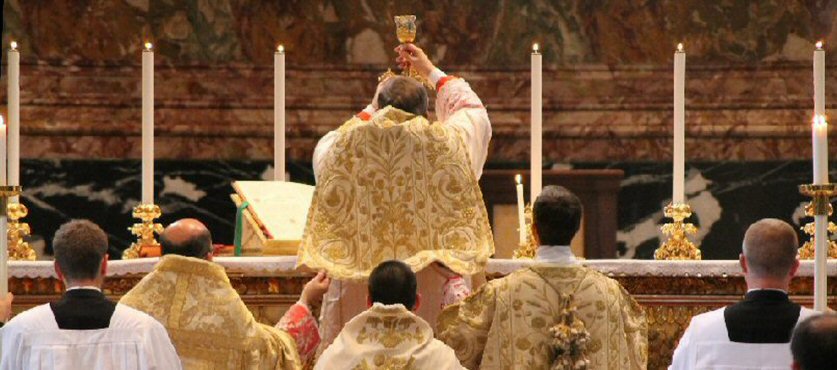Una Voce Hungary
László Dobszay - Miklós István Földváry
Those educated in liturgical spirituality looked with gladness and great expectations on Vatican II also in Hungary. They interpreted the reform according to the spirit of the liturgical movement of the recent century, and supposed that the task is not to change the Roman rite/but to lead it to a fuller implementation in the religious culture and spirituality of priests and all the faithful. With this hope a small group of laymen and priests started the work, and founded the St Augustine Movement for Liturgical Restoration, in spite of the unfavorable political situation (sometimes also under the danger of existence). Though followed suspicion rather than support of the hierarchy, the continuous activity earned remarkable success during the recent three decades.
The books published by the St Augustine Movement made possible to sing the chants of the traditional Roman mass by small choirs, and even congregations. The Roman office has been issued in series of good Hungarian and Latin-Hungarian translations set to Gregorian tunes. Based on the achievements of a generation of great scholars we recognized and applied the view that the ancient rite of the Hungarian churches in use until the 17th century is an excellent representative of the Roman rite - as are all the medieval regional traditions with a considerable past - in many respects richer than its Tridentine, it means curial-Franciscan form. It was right to suppose that after the Council some elements of this tradition can be restored. The greatest impact of activity, however, can be felt in the human side of the liturgy. The movement has convinced many young people, taught them the liturgy, spread its true spirit and practice. Books containing the Roman rite were given in their hands, they were trained how to use them in community and how to receive in their hearts. The movement defended the Liturgy against the ruining forces. In cooperation with the church musicians it cultivated the noble heritage of the sacred music, first of all the Gregorian one (that was propagated beside the Latin forms also in vernacular as it had been done already in thie 16-17th century Hungary). The classical polyphony found its basis in groups of singers, trained on a high level in the Liszt Ferenc Music Academy.
We had to see, however, with great regret, that the Church ad a whole practically dropped the ideals of her great teachers, like Gueranger, die Walter brothers, Odo Casel, Romano Guardini and others. It has happened, what Joseph Ratzinger still as a cardinal formulated so: a break has been done in the history of liturgy. And we may add: a break of Neo-Gallican character. The antitraditionalist turn is manifested also in the official liturgical books, most efficiently not even in the much criticized Ordo Missae, but still more in the Proprium Missae, the Rites of the Holy Week, of the Sacraments, and most annoyingly in the Divine Office (that we regard not as prayer book regarding only to the clergy, but as an integer part of the conventual ecclesiastical office). (Cf. DOBSZAY: The Bugnini-Liturgy and the Reform of the Reform.) The socalled reform, however, resulted, still farther going, in earlier unimaginable changes and abuses in the widespread practice.
This turn comforted us in our ideas, but made our job more difficult in ecclesiastical environment. The contact with the Una Voce - through its president - renders timely to make clear our standpoints that can be summarized in three points:
1. We are happy to promote the settlement of Una Voce in Hungary and the restoring of the traditional Mass in its 1962 form in this country. We think it would be a great blessing if the texts, structures, forms and mainly the spirit of the Roman rite would be present and effective in the country. For this sake we are ready to initiate - parallel with the St Augustine Movement - the founding of a Hungarian Una Voce group.
2. On the other hand, we firmly attach to the result reached at till now, namely: not to reject also the framework of the Novus Ordo, but to use its alternative options for presenting the liturgy in its most ecclesiastical and most traditional shape in the Catholic communities. In this context we especially wish to conserve our bilingual liturgical practice, included the vernacular liturgical chant (parallel with the Latin one), first of all in the Liturgia Verbi, in worthy translations and Gregorian tunes.
3. Our vision transcends, however, both - temporary - solutions. If we think it necessary to return to the 1962 state, it is with the will of preparing the stolen true reform, which is neither to demolish the traditional Roman rite, nor to close it in a reservatum, but to make it by a breakless, organic development again alive, restoring it with legal varieties but as the unique rite of the Catholic Church. In this respect our task today is to learn, meditate, discuss of the true reform and to pray for it. Though we live in a small local church, it can be said, we made a good progress also on this way in the last years.
We would be happy if the international FIUV could recognize the value of our activity, offer its support, and accept the Una Voce Hungary as "an association which pursue similar aims to those of the FIUV" (as formulated in your basic chart).
